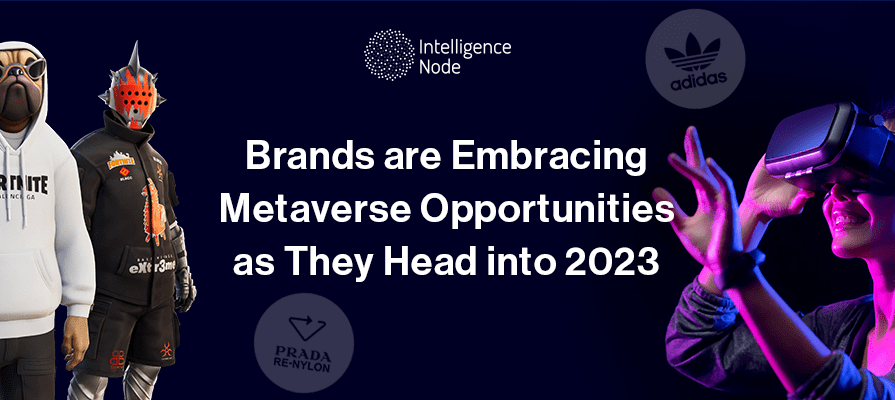Is the Metaverse Leading a New Revolution in Retail?
The metaverse, an interconnected virtual world where people can come together, work, and shop, as 3D avatars of themselves, is fast becoming accessible, especially with web3 providing a solid infrastructure for the metaverse to develop. The metaverse market is forecasted to surpass $800 billion in 2024. That represents a compound annual growth rate (CAGR) of more than 13%. The Metaverse is fast gaining mainstream attention largely through gaming platforms. Just a few years ago, the metaverse felt like a distant fantasy concocted by techies and seen in dystopian Sci-Fi series and movies like Black Mirror and Ready Player One. But now the metaverse is at our doorstep and all we have to do is open the virtual door and dive in.
While eCommerce ruled during the pandemic and became an indispensable part of the retail ecosystem, we may surpass it for a more immersive, digital, and interactive metaverse experience. The future looks promising with investments pouring in as the metaverse and web3 display an $8 trillion opportunity.
While the metaverse is still in its infancy, that hasn’t deterred brands from investing in it and testing new ways to interact with and acquire customers – especially the digitally savvy Gen Z and Millennial shoppers. Luxury brands and fashion and apparel retailers are the first to capitalize on the metaverse gold rush and are making waves with their innovative campaigns and collaborations. The question on everyone’s mind is, is the metaverse the next big thing in retail? Although it is too early to say with full confidence, we do feel that it is fast picking up momentum and it is on its way to transforming retail like never before. Let us find out what brands can do to leverage this new kid on the block before it’s too late.
Unlocking New Opportunities with the Metaverse
- Raise capital
- Find new avenues to sell products
- Bridge the currency gap
- Get creative with online and offline partnerships
- Improve brand recognition through immersive marketing
- Increase consumer loyalty through elevated experiences
- Use metaverse to launch and test new products
- Impart trust and transparency in your transactions.
1. Raise capital
Whether you are a start-up that needs to raise capital to grow your business or an established brand looking for avenues to raise capital to expand or innovate, NFTs provide a great platform for the same. Due to their versatile nature and complete authenticity and transparency, companies could create NFTs. In 2021, the total NFT sales reached a whopping 17.1 billion, a 200x growth over 2020. By launching and selling NFTs on marketplaces, you can raise much-needed cryptocurrency funds through NFT sales. NFTs are flexible, adaptable, and guarantee authenticity, being backed by data and blockchain, making them an ideal, structured means to raise capital. You can offer high utility and additional perks to customers for the NFTs to get them interested.
2. Find new avenues to sell products – virtually and physically
The metaverse gives you a whole new avenue to sell your products. You are no longer confined by physical space or geographic limitations. The global metaverse market size is projected to grow from USD 61.8 billion in 2022 to USD 426.9 billion by 2027, at a Compound Annual Growth Rate (CAGR) of 47.2%. Further, you can sell virtual products in the metaverse in the form of NFTs through video game collaborations or virtual stores- a whole new untapped market. You can also sell physical products through the metaverse and generate additional revenue. Additionally, you get to expand your audience base and target newer audiences and the younger Gen Z demographic, which is highly invested in the online, virtual space.
One example of successfully leveraging the metaverse to generate revenue is the luxury brand Gucci. Gucci is proving that there is real money to be made in virtual goods. The Italian fashion house has offered a wide range of digital items for sale in 2021, from $13 virtual sneakers to a unique Roblox handbag that resold for more than $4,000 and a video NFT auctioned by Christie’s for $25,000.
3. Impart transparency in your transactions
A huge benefit of NFTs and the blockchain technology they’re built on is trust and transparency. Since the blockchain is a digital and public ledger with records of every single transaction that has occurred on the blockchain, you can transact with other businesses and your consumers in a completely trustworthy and transparent manner.
You know exactly who, what, where, and when anything happens on the blockchain before it happens and after the transaction as well. Plus, smart contract technology allows all the rules and terms of your offerings to be included in the NFT and recorded on the blockchain.
This means there doesn’t have to be any confusion as to what is being offered and accepted from either side of the transaction. If there is any kind of questionable transactions or terms, the blockchain will expose them instantly.
4. Improve brand recognition through immersive, cross-channel promotions
Brands can build experiences in the metaverse like the Gucci Garden, an immersive, unique virtual exhibit, Nikeland, Nike’s purpose-built showroom, WendyWorld, Wendy’s virtual restaurant, etc. to improve brand recognition. Apart from this, brands can create a buzz around the brand by doing virtual events, collaborating with online games, inviting shoppers to virtual exhibits and experiences, launching limited edition NFTs in the form of virtual collectibles, showcasing a new range of clothing and accessories through virtual fashion shows and merging both virtual and real worlds by creating unique, cross-channel engagements.
5. Increase consumer loyalty through elevated experiences
In today’s age of fast fashion, price sensitivity, and intense competition, building customers loyal to your brand needs a lot more effort than before. Offering a few loyalty points or early access to in-store sales is not enough to keep consumers loyal. Metaverse can be used effectively for this purpose. It transcends the barrier between online and offline and can be used to make consumers feel special, appreciated, and engrossed with your brand. A few ways to leverage metaverse and web3 for consumer loyalty are:
- VIP passes for physical and virtual events
- One-on-one interactions with customers
- Airdrops of future NFTs
- Offer different levels of NFT utility and perks
- Offer exclusive access to new NFTs
6. Use metaverse as a springboard to launch and test new products
Launching a new product comes with significant risk and an even greater expense. Wouldn’t it be better if you had intelligence on how your consumers perceive the new products before you launched them in the real world? Using metaverse to test your new launches comes with lesser risk and expense. In fact, 43% would try out a new product or service in a virtual world before buying12. Inviting customers to try out new colors, prototypes, and proofs-of-concept and hearing their views first-hand is a powerful analytical tool that marketers could leverage through the metaverse.
Metaverse Challenges
While preparing your move into the metaverse seems like the right choice, it’s important to weigh the pros and cons before taking the plunge and investing large sums in building the infrastructure. The Metaverse doesn’t come without its challenges and although a lot of research is pointing towards its inevitable growth in the coming years, there is also speculation that it might not grow to be a mainstream platform where all shoppers go to interact, explore, and buy. Below are a few challenges that brands and retailers must consider before investing in the metaverse;
- Lack of data privacy and security norms
- Underdeveloped payment and digital infrastructure
- Low awareness & adoption of blockchain
- Organizational immaturity
- Laws, taxation, and regulatory changes
- Lack of historical data to support investments
- Ownership of property and verification inconsistencies
Preparing for the Future of Virtual Retail – Our Thoughts
The metaverse is still in its early stages and the timeline for it to evolve into the next big thing remains unclear. But, looking at where it is headed, it is safe to say that its development might mimic that of the internet. The internet didn’t become perfect in its first Web 1.0 version itself but took a couple of iterations to become commonplace, mainstream and what it is today. The metaverse might follow a similar growth trajectory and take some time before its commercial and business opportunities become common and accessible to all.
- Companies will need to embrace the foundational technologies underpinning the metaverse while adapting nimbly to its rapid rate of change to make any of these use cases a reality. For example, with the required technology and design skills required to build NFTs, brands will not succeed in their effort to enter new markets through NFTs.
- It would be nearly impossible to create a virtual storefront without a cloud-based infrastructure. It may prove difficult to sell branded digital products to a new metaverse consumer segment without solid and real-time data that reveals consumer preferences. A metaverse-based strategy requires clean, accurate data, cloud-computing capabilities, and technology structure to manage digital partnerships.
- As more brands open stores in the metaverse, competitive intelligence will play a key role in having real-time visibility into competitor product and price movements. Intelligence Node is positioned to gather competitive data from the metaverse stores, which can give brands a major advantage while pricing, positioning, and promoting their products in the metaverse.
Optimize your metaverse stores and inventory with advanced competitive intelligence : Tell Me How!
- No one knows where the metaverse might lead us to. However, we can say with near certainty that the cat is out of the bag, and there is little chance of the metaverse momentum slowing down or coming to a halt. The bottom line is – The metaverse is here and is a bearer of exciting opportunities and endless possibilities. Considering the accelerated rate of digitization in the last two years, chances are that metaverse develops into the next internet before retailers have time to catch their breath. Retailers should catch the metaverse wave by selectively investing in the most promising technology that becomes too large to ride on.
If you found this useful and you’d like to learn how to take your eCommerce strategy to the next level, we invite you to download our free “The Metaverse is Revolutionizing How Consumers Shop” eBook. Click below to access the ebook now!





